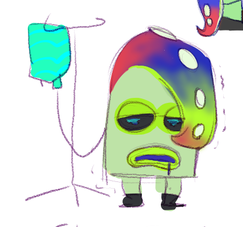|
back 
SanitizationSanitization is a lethal process in which cephalings are "zombified" via killing their beneficial bacteria. The process also wipes the mind, resulting in victims not remembering anything prior to sanitization, and more often than not instilling a sort of mind control.Kamabo was and is notorious for this, leaving hundreds of cephalings in a state of living death, for better or worse. Sanitization comes with a lot of problems, which get especially bad for the escaped sani, since most were sanitized while the method was still pretty experimental. I'm lucky to have a ton of experience with this, y'know, being sanitized myself, but also because I've gotten to befriend so many other sanis and do loads of research into our shared condition. - MethodsSanitization is done through a number of methods.Most common is through a number of the many machines on the Sanitization line in Kamabo Co.'s facility. This produced sanitization "batches" while the method was still being researched. Some batches are less stable than others, health-wise.  IV infusion is a slow but more meticulous method, for when a sanitizer wants more control over the process. Kamabo has a medical wing dedicated largely to this. Infusion will get brought up again later. Syringe Chargers, the signature weapon of a sanitizer, can also sanitize with a number of well-aimed shots, normally to the head. However, this method is notably HIGHLY painful, as the Syringe Charger's shots are piercing. 
Sanitized GelSanitized "ink" isn't ink at all. Ink is an oil-based substance, where the sanitized variant is an alcohol-based one. It's more accurate to call it a gel rather than an ink. This cyan-green-teal gel is a non-color-changing default for all sanitized, where ink production organs produce heavy amounts of alcohol instead of oil. A number of sanitized (not all) can produce normal ink, but it always has hints of alcohol in it even then.Sanitized gel is a very powerful base known for causing chemical burns. It consists of many chemicals, but is mostly high-pH isopropyl alcohol (rubbing alcohol) and lye. Even brief contact with sanitized gel can cause severe chemical burning, nerve damage, and dermatitis. But getting it in you will do a lot, lot worse. - What it DoesSanitized gel works by targetting all the bacteria in your body. As cephalings, we have a mutual dependancy on the beneficial bacteria that lives around, on, and in us. Without it, we would die. The high alcohol content of sanitized gel kills this bacteria, and most other things it touches.It's completely unknown how it puts people into a state of living death though, nor how it makes people lose their memory. Leading theories presume that the beneficial bacteria we share a symbiotic relationship with have very important roles in our brains. Not every sanitized is brainwashed off the bat, it's assumed this is something Kamabo proper has some hand in. - The ProsMilitary Proess and Interconnectivity The sanitized are a bioweapon, fundamentally. We are machines made to kill, and kill painfully. The sanitized are designed to be the monsters the Surface would fear, had Tartar's plans succeeded.
The sanitized are a bioweapon, fundamentally. We are machines made to kill, and kill painfully. The sanitized are designed to be the monsters the Surface would fear, had Tartar's plans succeeded.The Octarians were a perfect start for Tartar, as Octarian culture instills a need for perfection and a drive for more into its people. Sanitization takes this and turns it up to 11, the brain working mindlessly towards whatever goal it is tasked with. For many sanitized, this meant military strength. A drive to be a better soldier, just like in the Octarian Army. This mindset, of course, drives many sanitized mad, and occasionally results in neglect of the self and outright harm to the self. The sanitized were designed with fast, mindless, unity in mind. This pseudo-hivemind is a survival instinct of the sanitized, and drives a lot of its culture and operation. The hivemind was originally meant to make units work together quickly and in unision, as to swiftly overwhelm the enemy. It has found many other purposes, however. The hivemind is extensive and can't be summed up here alone. You can read more about it here. Partial ImmortalitySanitized are undead, there's no doubt about it. We do not age, we can't get sick with infections, and generally the body restores itself even in death.However, this immortality is partial, and poorly understood. We don't know if we can die of old age at all, but it's looking very unlikely. The point of the sanitized body is to work, and not to stop, so it simply doesn't. There is not time to rest according to it, even as one gets older. Sanitized aren't immune to harm though, and most known cases of a sanitized dying are from fights or accidents. Sanitized Medicine For the sanitized, however, sanitized gel can be a boon. Even if it caused and causes a lot of the medical issues sanitized suffer, infusions via IV can mitigate symptoms, the same way a normal ink IV can help treat a few conditions in non-sanitized.
For the sanitized, however, sanitized gel can be a boon. Even if it caused and causes a lot of the medical issues sanitized suffer, infusions via IV can mitigate symptoms, the same way a normal ink IV can help treat a few conditions in non-sanitized.This puts sanitized in a weird state of both relying on their gel and being hurt by it. Functionally, to us, it's identical to normal ink, and it's not caustic to sanitized the way it is to non-sanitized. But by having killed all bacteria in our bodies and continuing to do so, it destroys the body. While sanitized can create their own gel, we all have limited amounts, the same way a non-sanitized has a limited amount of ink in their lifespan. To infuse yourself with your own gel is to have a net gain of zero. You can infuse with another sanitized's gel, but that's often at their expense. The best practice, while unsustainable in long-term, is theft: stealing IV bags which Kamabo Co. produces themselves yields best results, and this is most likely due to a difference in chemical makeup of Kamabo IVs versus the gel from a sanitized. It's hard to explain and there's lots of unknowns, but it's most likely that the gel stored in Kamabo IVs come from a place where sanitized gel was originally created, instead of being gel extracted from a sani. Getting IVs from Kamabo, of course, is dangerous work. With my knowledge of the facility, I'm lucky to keep a lot in stock in general, and like many Kamabo objects, these IVs sometimes find their way to the Surface through other means and may end up in stores. If you ever need any, please do contact me! The science of "sanitized medicine" is a delicate one with a lot of mysteries to unravel. While it's an art perfected by the Kamabo Co. sanitizers and scientists, it's unknown on the Surface. I've been making great strides in studying it through self-treatment and helping out others. |